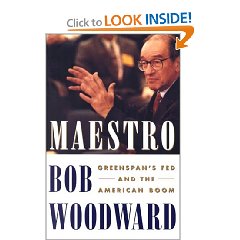November 16, 2000
Bob Woodward
I am quite taken with this book, which at 234 pages is “just right” and well crafted and edited to tell an important story. This is a story about applied intelligence in the finest sense of the word. It is a story about a man well-versed in traditional economic research, traditional models, traditional assumptions about the marketplace, who was put into the most important position in the global financial system at just the right time. His intuition allowed him to detect unexplained changes in productivity and to direct new lines of research that helped persuade more conventional authorities to follow his strategy. This is also a story about a uniquely successful partnership between a Republican central banker and a Democratic President-the very heart of the story centers around Greenspan's ability to persuade a very smart President that deficit reduction was the critical ingredient for a long-term restoration of American prosperity. Aided by an equally smart Secretary of the Treasury, Rubin, it was the President's initiative to reduce the deficit by over $140 billion dollars that allowed all else to follow. There is a clear message here for those who would reduce taxes before finishing the job of eliminating the deficit. As a professional intelligence officer, I am very very impressed by the author's recounting of how Greenspan actually “does” the job of intelligence collection and analysis at his level-the Central Intelligence Agency could learn a great deal from this man. The integration of constant (every fifteen minutes) monitoring of key indicators, the preparation of detailed research and statistics reports, and-by far the most important element-the continuous cycle of direct telephone calls and personal meetings across all sectors of the economy and around the globe, define what must be the most efficient and effective and valuable directed intelligence operation in the world-and one that does not steal the information it needs! There are a number of observations throughout the book that are helpful at a strategic level: 1) deficit reduction is the single best thing any President can do-that enables the Fed to be effective; 2) we forget so quickly how desperate the American economy was in the late 1980's-in a volatile world it would be all too easy to enter a recession or have a major financial panic; 3) structured decision-making is extremely dependent on the models and the data-Greenspan's place in history is assured because he had the intellect and the patience and the gut instincts to realize that the data was incomplete or too aggregated and the modeling assumptions were dated and no longer sufficient to plot the course of the new economy; 4) the psychology of the marketplace is at least as important as the reality, and is likely to be hurt by loose-cannon White House elements with good intentions but out of bounds; 5) even the so-called best and brightest in any Presidential administration will categorize new ideas they do not understand as “incoherent if not idiotic”, as Greenspan's emerging new ideas were labeled by the top Treasury economists; 6) the concept of wealth redistribution fails to understand that even if $1 trillion from the 225 richest people in the world were redistributed to the poorest of the earth, this would only give them $1 a day for a year-Greenspan's focus is on underlying structural changes and the advancement of capitalism such that wealth can be created for the poor on a sustained basis; and 7) there will always be wild cards, such as the Savings & Loan crisis, the LTCM (Long Term Capital Management) crisis, and the Mexico crisis, that require a financial management or central banking network able to capitalize on personal relationships and deep knowledge to find impromptu solutions. On the latter note, it makes one realize that in an increasingly volatile marketplace, there should probably be much stricter limits on “leveraged” actions, where the majority of the money for gambling on the stock market or in the bond market-as much as 95% of the money-is borrowed and therefore likely to be defaulted if the wrong bet is placed. There is nothing in the book regarding any steps that Greenspan has taken or is considering in order to bring added stability to the marketplace. If I have one criticism of this otherwise superb book, a book that sheds light on many aspects of the Fed and its Chairman, it is that there is no hint here of what Greenspan has learned that might lead him to suggest legislative or regulatory changes intended to improve public transparency of key economic transactions, limitations on risk intended to prevent one rogue elephant (e.g. LTCM) from bringing down the market, and so on. I would have liked to see a summation, even a two-page appendix, on the “before” and “after” economic models that Greenspan helped to change, and also some sense in the conclusion of what needs to be changed to keep future market crises within the bounds that can be managed by the Fed-Greenspan clearly has broad shoulders and a broad mind, but he can't carry the load forever and this book fails to focus on what changes are needed to institutionalize the Greenspan wisdom.





